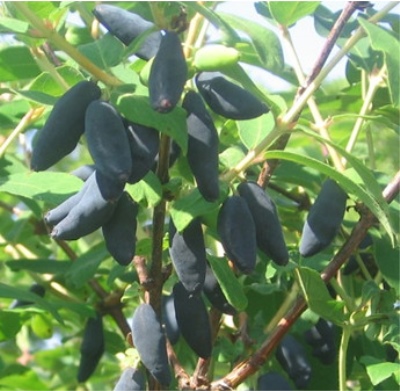
- Authors: Andrey Vasilievich Gagarkin, Nadezhda Viktorovna Savinkova
- Year of approval: 2017
- Growth type: vigorous
- Description of the bush: sparse
- Escapes: medium, straight, brownish brown, hairless, matte, curved at the apex
- Leaves: medium, green, slightly pubescent, matte
- Transportability: medium
- Fruit size: large
- Fruit weight, g: 1,8-2,7
- Fruit shape: broadly fusiform
Among the early maturing varieties, varieties of the OGUP Bakcharskoye enterprise are highly popular. Honeysuckle Strezhevchanka is a striking representative of this line. Its fruits have a universal purpose: fresh consumption, preparation of tasty and healthy mousses, yoghurts, cottage cheese desserts, cooking compotes, preserves, jams, baking, freezing and even making wine.
Description of the variety
The variety belongs to vigorous (up to 180 cm) shrub-type plants. Beautiful spreading bushes have a sparse structure, consist of straight, medium and long shoots, covered with a smooth matte bark of brown-brown shades. The shoots curved at the very top give the bushes a decorative look.
Weakly pubescent green leaves have a matte surface. The plant blooms in May and blooms until the crescent, forming new buds, ovaries and withstanding spring frosts down to -8 ° C. With all its positive qualities, the variety cannot be used for cultivation on an industrial scale, since it is unsuitable for mechanized harvesting and long-term transportation.
Fruit characteristics
Large (1.8-2.7 g) wide-fusiform berries have a dark purple color that turns into black tones. The thin skin is covered with a slight bloom of pruin.
Taste qualities
The juicy and tender pulp of the fruit has a sweet-sour dessert taste and a medium-strength aroma. The berry contains: sugar - 8.8%, acids - 3.2%, vitamin C - 27.5 mg. Honeysuckle is not prone to shedding, the assessment of the tasting committee is 4.9 points.
Ripening and fruiting
An early ripe variety gives the first (test) harvest in the fourth year after planting. Full return starts from the fifth year. The maximum return from the bush lasts from 3 to 5 years, then the decline in performance begins.
Yield
Strezhevchanka belongs to high-yielding varieties: on average, up to 2.5-3 kg are removed from one bush, the maximum indicators are 4.5 kg and more.

Growing regions
The variety is adapted for the regions of Western Siberia, but feels great in the Urals, Altai, etc.
Self-fertility and the need for pollinators
Strezhevchanka belongs to self-infertile varieties and needs a neighborhood with pollinators. Honeysuckle is ideal for a similar role:
- The daughter of a giant and Silginka;
- Delight, Yugana and Bakchar giant.
High-quality pollination occurs when planting at the rate of 1 bush from the above for 5-6 Strezhevchanka bushes.
Growing and care
The size of the landing pit is 40x40x50 cm, the shape is a well with vertical walls and a flat bottom. It is imperative to equip the pit with a drainage layer of 8-10 cm. The dug soil is enriched with organic matter (compost, humus, bird droppings), superphosphate and baking powder in the form of river sand if the soil is too dense and heavy.
When planting, you need to monitor the root collar: it should be at the level of the surface or slightly higher. With an open root system, the roots are gently spread over the surface of the earthen mound in the pit and only after that they are covered with earth, at the same time compacting it to prevent the formation of voids.After that, the near-trunk circle is well watered with warm water, the next day the moist soil is loosened and covered with mulch to prevent drying out and crust formation.
Further care consists in regular watering, fertilizing, pruning and shaping the crown.
- An adult plant is watered 3 to 4 times per season: flowering, after picking the berries, in autumn.
- Top dressing begins 2-3 years after planting. In the spring, nitrogen-containing preparations, for example, urea, are introduced. During filling, the plant requires potassium-phosphorus preparations; in the fall, the trunk circle is covered with humus.
- Sanitary pruning is done in early spring by cutting out old, diseased, dry and damaged shoots. They are engaged in the formation in late autumn, after the cessation of sap flow and starting from the age of 6. If the bush is formed on a trunk, then the process is carried out annually after planting.
To ensure a good wintering, abundant watering, cleansing the site and renewing the mulch layer are enough.


Disease and pest resistance
The described honeysuckle has strong immunity and, as a result, high resistance to the most common diseases:
- fungal;
- bacterial and viral.
Practically not affected by aphids. But for prevention, it is necessary to carry out treatments with insecticides and fungicides.

Winter hardiness and the need for shelter
The bushes of the Strezhevchanka variety are distinguished by high winter hardiness, but they do not tolerate drought worse.
Location and soil requirements
Strezhevchanka prefers open sunny places with maximum illumination and heating. In this case, you should take care of protection from northern winds and constant drafts. Honeysuckle is planted under the protection of walls and blank fences. It grows well on peat bogs and loams, alumina and sandy loam, chernozems, gray forest soils, as well as sod-podzolic soils and volcanic sand. As for acidity, it is much easier for the gardener: the permissible pH level is in the range from 4.54 to 7.5.
































































